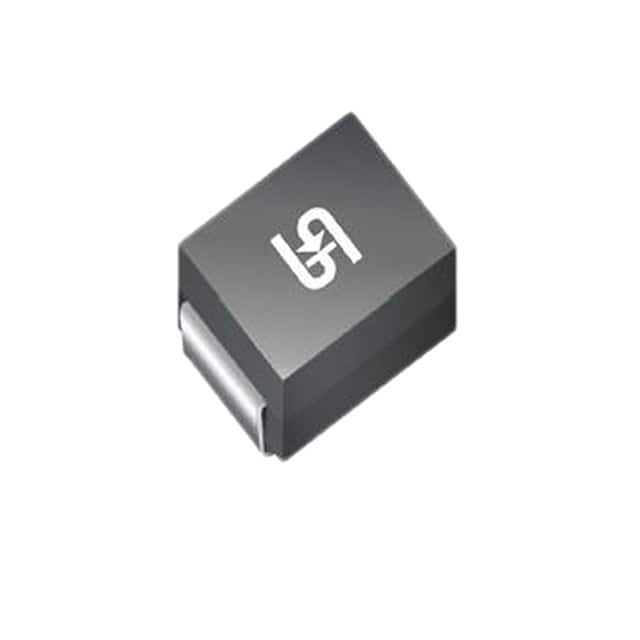SMBJ36CAHM4G
Product Overview
- Category: Electronic Component
- Use: Voltage Suppression in Electronic Circuits
- Characteristics: Fast response time, low clamping voltage, compact size
- Package: SMB (DO-214AA)
- Essence: Transient Voltage Suppressor Diode
- Packaging/Quantity: Tape & Reel, 3000 units per reel
Specifications
- Peak Pulse Power: 600 Watts
- Breakdown Voltage: 36V
- Clamping Voltage: 58.1V
- Operating Temperature Range: -55°C to +150°C
- Storage Temperature Range: -55°C to +150°C
Detailed Pin Configuration
The SMBJ36CAHM4G has two pins, with the anode connected to pin 1 and the cathode connected to pin 2.
Functional Features
- Provides protection against transient voltage spikes
- Fast response time ensures minimal damage to sensitive electronic components
- Low clamping voltage prevents overvoltage damage
Advantages
- Compact size allows for easy integration into circuit designs
- High peak pulse power handling capability
- Wide operating temperature range for versatile applications
Disadvantages
- May exhibit leakage current at high temperatures
- Limited breakdown voltage compared to some alternative models
Working Principles
The SMBJ36CAHM4G operates by diverting excess voltage away from sensitive components in a circuit, thereby protecting them from damage caused by transient voltage spikes. When a voltage surge occurs, the diode rapidly conducts, providing a low-resistance path for the excess energy to be dissipated as heat.
Detailed Application Field Plans
- Telecommunications: Protects communication equipment from lightning-induced voltage surges
- Automotive Electronics: Safeguards vehicle electronics from voltage transients
- Industrial Control Systems: Shields control circuitry from power supply fluctuations
Detailed and Complete Alternative Models
- SMBJ5.0A: Breakdown Voltage: 5V, Peak Pulse Power: 600W
- SMBJ15CA: Breakdown Voltage: 15V, Peak Pulse Power: 600W
- SMBJ100A: Breakdown Voltage: 100V, Peak Pulse Power: 600W
This concludes the detailed entry for the SMBJ36CAHM4G, covering its product information, specifications, functional features, advantages and disadvantages, working principles, application field plans, and alternative models.
10个与SMBJ36CAHM4G在技术解决方案中的应用相关的常见问题及解答
What is the SMBJ36CAHM4G?
- The SMBJ36CAHM4G is a transient voltage suppressor diode designed to protect sensitive electronic components from voltage spikes and transients.
What is the maximum working voltage of the SMBJ36CAHM4G?
- The maximum working voltage of the SMBJ36CAHM4G is 36V.
What is the peak pulse power of the SMBJ36CAHM4G?
- The peak pulse power of the SMBJ36CAHM4G is 600W.
What are the typical applications of the SMBJ36CAHM4G?
- The SMBJ36CAHM4G is commonly used in applications such as power supplies, telecommunications equipment, automotive electronics, and industrial controls to protect against voltage transients.
What is the clamping voltage of the SMBJ36CAHM4G?
- The clamping voltage of the SMBJ36CAHM4G is typically around 58.1V at 10A.
What is the operating temperature range of the SMBJ36CAHM4G?
- The SMBJ36CAHM4G has an operating temperature range of -55°C to 150°C.
How does the SMBJ36CAHM4G provide protection against voltage transients?
- The SMBJ36CAHM4G conducts excess current away from sensitive components when a transient voltage spike occurs, thereby protecting them from damage.
Is the SMBJ36CAHM4G RoHS compliant?
- Yes, the SMBJ36CAHM4G is RoHS compliant, meaning it meets the Restriction of Hazardous Substances directive.
What is the package type of the SMBJ36CAHM4G?
- The SMBJ36CAHM4G is available in a surface mount DO-214AA (SMB) package.
Are there any recommended layout or mounting considerations for the SMBJ36CAHM4G?
- It is recommended to minimize the length and area of the traces connecting the SMBJ36CAHM4G to the circuit to reduce inductance and maximize its effectiveness in suppressing transients. Additionally, proper thermal management should be considered during mounting to ensure optimal performance.


